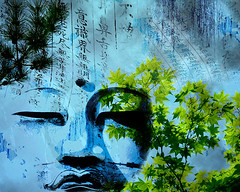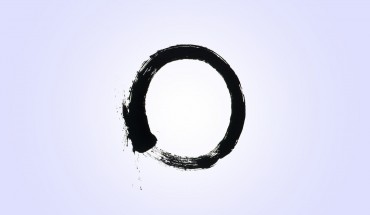…and started something else. 
I admit – this was just for my amusement. Below you will find a Pali version of the famous Mahayana text the “Heart Sutra” which I attempted to “translate” (back) into Pali.
The purpose of this exercise was to learn how closely (or not) early Mahayana texts were to the Theravadin tradition – not just in letter but to a certain degree in spirit. On the other hand, I also wanted to see how they started to deviate from each other. The Heart Sutra belongs to a group of early Mahayana texts who seem to have started out to as a criticism on abhidharmic scholasticism but by doing so it seems that they triggered other misconceptions.
It is interesting to see how “Buddhism” deviated further and further from the simple original hands-on suttas which record Buddha’s training methods. It is interesting, because trying to keep the Dhamma authentic and workable is a never-ending struggle against the flow of samsara 🙂
In fact, this famous text could have been part of the pali canon (if the pali canon would have been allowed to incorporate new texts forever, that is. Luckily Ashokas 3rd Buddhist council prevented just that). If you do not know any pali you might still find the footnotes quite enjoyable 🙂
Blue highlighting is for expressions/terms uncommon to pali texts which are the “real” Mahayanic add-on or alternative Sanskrit usage which is alien to pali texts.
Translation of the text in English here, history and background here.
This is the Buddhist Sanskrit Version the following pali version is based on
My “would be” Pali version:
Paññāpāramitā-hadayasuttam|
|namo sabbaññāya(1)||
Evaṁ me sutam| ekam samayam bhagavā rājagahe viharati gijjhakūṭe pabbate mahatā bhikkhusaṁghena saddhiṁ mahatā ca bodhisattasaṁghena| tena kho pana samayena bhagavā gambhīrāvasambodhaṁ(2) nāma samādhiṁ samāpanno| tena ca samayena ariyo Olokitissaro bodhisatto mahāsatto gambhīraṁ paññāpāramitaṁ cariyaṁ caramānā evaṁ voloketi(3) (i.e. vipassati)| pañcakkhandhā. Tañca sabhāvasuññaṁ voloketi(4)||
Atha kho ayasmā Sāriputto buddhānubhāvena(5) ariyam Olokitissaraṁ bodhisattam etadavoca:- yo hi koci kulaputto vā kuladhitā vā ayaṁ gambhīraṁ paññāpāramitaṁ cariyaṁ caritukāmo, kathaṁ sikkhitabbam? evam vutte ariyo Olokitissaro bodhisatto mahāsatto āyasmantaṁ Sāriputtam etad avoca- Yo koci Sāriputta kulaputto va kuladhitā vā gambhīraṁ paññāpāramitaṁ cariyaṁ caritukāmo, tena hidaṁ voloketabbam: – pañcakkhandhā -tañca sabhāvasuññam samanupassitum| rūpaṁ sūññatā(6), sūññatā hiva rūpam| rūpam na aññam(7) suññatā, suññatāya na aññam rūpam| yam rūpaṁ sā suññatā, yā sūnyatā tam rūpam| evaṁ vedanāsaññāsaṁkhāraviññānañca suññyatā |
Evaṁ Sāriputta sabbe dhammā suññatālakkhaṇā. Anuppannā aniruddhāamalā avimalā anūnā asampunnā| Tasmātiha Sāriputta suññatāyaṁ na rūpam, na vedanā, na saññā, na saṁkhārā, na viññānam, na cakkhum na sotaṁ na ghaṇaṁ na jihvā na kāyo na mano na rūpaṁ na saddo na gandho na raso na potthabbam na dhammo| na cakkhudhātu na manodhātu na dhammadhātu na manoviññānadhātu| na vijjā na avijjā na khayo na jarāmaraṇaṁ na jarāmaraṇakhayo, na dukkhasamudayanirodhamaggā na ñānaṁ na patti na-apatti| (8)
Tasmā Sāriputta apattiyā(9) bodhisatto paññāpāramitanissitā (10) viharati acittāvaraṇam| cittāvaraṇa-natthitā-anutrasto viparilāsātikkamānto niṭṭhitanibbānam| tividhavaṭṭhānā sabbe buddhā paññāpāramitānissitā anuttaraṁ sammāsaṁbodhimabhisaṁbuddhā| tasmā ñātabbam: paññāpāramitā mahā-manto(11) anuttara-manto asamasama-manto sabbadukkhapasamana-manto saccam-amiccatā paññāpāramitā-vutto. manto tam yathā- “gate gate pāragate pārasaṁgate bodhi svāhā”| evaṁ Sāriputta gambhīrāyaṁ paññāpāramitāyaṁ cariyāyāṁ sikkhitabbaṁ bodhisattena (12)||
atha kho bhagavā tasmā samādhim uṭṭhāya ariyo Olokitissarassa bodhisattassa sādhukam adāsi- “sādhu sādhu kulaputta| evametam kulaputta, evametam gambhīrāyaṁ paññāpāramitāyaṁ cariyaṁ caritabbaṁ yathā tayā vidiṭṭham| anumodayate tathāgate arahate||
idam avoca bhagavā| attamano āyasmā sāriputto ariyo Olokitissaro ca bodhisatto sā ca sabbāva parisā devamānussāsuragandhabbaca loko bhagavato bhasitam abhinandunti||
iti paññāpāramitāhadayasuttaṁ samatittham|
Footnotes:
(1)In a proper pali text we would of course have a reference to the Buddha at this point like: “namo tassa Bhagavato”..instead this text venerates omniscience (sabbanna). With regard to the title: the ‘hadaya’, lit. meaning ‘heart’, i.e. ‘essence’ must be a Sanskrit expression as well. In pali such a ‘stamp’ or concise teaching by the Buddha would be called ‘uddesa‘
(2)sammasambodhim/animitta/phalasamapatti in pali. but that would be too arahantish, that’s why we need a new term here, after all, it’s a Mahayana text 🙂
(3)Hey, the Bodhisatta is doing vipassana!! vi-ava-loketi (to look at precisely) Well, why not! After all, this is about training the wisdom paramita of a Bodhisatta. So someone looking to become a Buddha sure needs training in vipassana. And, as we know from modern day vipassana trailblazers like Ven. Mahasi Sayadaw and Ven. Sri Matara Nyanarama, someone with a defined “prarthana/patthana” will not get beyond the vipassana stage of sankharupekkha-nyana :-). In this sense, this is nothing new to the ancient Buddhist tradition.
(4)Interesting: The Buddha would talk about the 5 groups always with regard to grasping (pancupadanakkhandha). The problem for him was the upadana – grasping/holding on to – the 5 groups. However, the methods he taught (esp. in Samyutta Nikaya, Khandha Vagga) to remove this inherent grasping involved labeling/seeing those 5 groups of grasping as “empty”. This seems to be exactly what the Bodhisatta Avalokitissaro or Olokitessaro does. Funny name, by the way. Is he really the Master of Compassion, as Mahayana traditionally explains his name (to look after or over beings from above, ava-lokita, in the same sense as the pali commentaries use this word such as ‘buddhacakkhunā lokaṃ oloketi – looking at the world with they eye of a Buddha’) or rather did he get his name from his mastery in insight meditation practice as the verb vi-ava-loketi in this context hints at…I guess it depends where the name of this fabled person appears for the first time.. On another note though, it implies some form of knowledge about the practice of vipassana/sammasati as seen in this sutta and could be taken as a Mahayanic acknowledgement of vi-passana to developing wisdom. Here is an example how oloketi is used in a similar context in the ancient (pali) Mahaniddesa:
“ākiñcaññāyatanaṃ samāpajjitvā tato vuṭṭhahitvā tattha jāte cittacetasike dhamme aniccato vipassati, dukkhato vipassati, rogato…pe… nissaraṇato vipassati dakkhati oloketi nijjhāyati upaparikkhatīti– tato tattha vipassati. – Having attained to the meditation stage (sphere) of Nothingness and from there having emerged whatever mindmental objects are born there he looks at them as impermanent, as suffering, as disease … etc…for escape, he looks closely (vipassati), sees (dakkhati), looks at (oloketi), muses (nijjhayati) and reflects (upaparikkhati) over them. [link]” –
as a side note: here you see how Buddhas advice to use these terms as labels (see: ‘this is empty’ – “rupam sunnam’ti pajanati) towards a more descriptive explanation (see as empty – sunnato vipassati). The former makes it a clear exercise to train with right away; the latter makes you wonder just how to do it. A fine but crucial difference – even if at the time when these commentaries were written this method of noting may have been still in place). See others posts on this topic on this blog, keyword “iti and sallakheti”.
(5) buddhanubhavena…a word which is found in later pali texts / commentaries as well. Especially in the context of pirit chanting…’by the power/might of the Buddha’
(6) “Emptiness”. Rather than a property in itself, the usage of “empty” in the old pali texts denotes the fact that sensing is based on forms-senses-and consciousness all three having to come together. They are thus void of a persisting independent entity, because they vanish as soon as the conditions for a sense impression vanish. This inherent characteristic of the empty nature of the sensory process (esp. how it presents itself to “us”) was substantialized in Mahayana and (as all other ‘names’ and ‘concepts’ ) it started to take on a life of its own. A text from the pali canon where a similar usage of the terms found so far can be located is the Patisambhidamagga (which was ascribed to Sariputta himself. Maybe that pun was intended, especially if you think how Sariputta became a symbol for the conceptual excess in Abhidharma scholastic literature)
Katamaṃ vipariṇāmasuññaṃ? Jātaṃ rūpaṃ sabhāvena suññaṃ. Vigataṃ rūpaṃ vipariṇatañceva suññañca. Jātā vedanā sabhāvena suññā. Vigatā vedanā vipariṇatā ceva suññā ca …pe… jātā saññā… jātā saṅkhārā… jātaṃ viññāṇaṃ… jātaṃ cakkhu…pe… jāto bhavo sabhāvena suñño. Vigato bhavo vipariṇato ceva suñño ca. Idaṃ vipariṇāmasuññaṃ.
Important difference of course: To the Buddha, ’emptiness’ as any other mental concoction has no value in itself. Rather – and only for the purpose of meditative training – it is important to see the vanity/emptiness/unreliability of any of the six sense impressions. This is why the pali texts talk about ’empty (of)’ and use the adjective, whereas in this age of the game Buddhism (Mahayana) had turned this concept [sic] into a philosophic reality. This is how suddenly samsara and nibbana would look identical and instead of using the boat to get to the other shore we start building our house on the boat. That will defnitely make it more habitable for others and prolong the journey for all.
(7) In the Sanskrit text it says “pṛthak” which is pali “puthu”. However, in pali texts the word “añña” is used instead.
(8) In this last paragraph complete and utter relativism sets in. If it wants to show/prove the emptiness of concepts it definitely goes into a ZEN-like training mode: Instead of describing the way how to overcome the spell of overpowering concepts (even Dhamma-thoughts are thoughts after all) it trashes all Buddhist and worldly concepts. See my discussion on the Lankavatara Sutta where a similar Mahayana-trait emerges.
(9) Funny: “Even though I have not attained to anything (being a Bodhisatta) I am already at the final nibbana, because, well, after all everything is nothing – and I have attained to that. 🙂 Okay…
(10)The Sanskrit text has a word which in pali would be “āsitā” (relied on/ based on). However in pali a similar word is more common for this purpose: “nissita” – meaning is the same.
(11) The word “mantra” in pali “manto” appears in the commentarial literature as well and means a “spell” a magic formula.
(12) This final paragraph is the climax of decay from a Theravadin point of view. The highest quality a future Buddha has to train himself in is reduced to uttering a mantra. While we started out with a tone and voice related to the pali texts we now either are faced with a koan or a mythical phrase which this text wants to make us believe is the source of the ultimate development in wisdom. I have my doubts 🙂 But I guess there are many other (more subtler) ways of reading this text.
So, besides the mantra, the following summary found on the Wikipedi website seems to make sense. This Mahayana text looks and feels like a response to the Abhidharmic materialism (which the Theravadin commentaries and Abhidhamma are equally infected with):
The specific sequence of concepts listed in lines 12-20 (“…in emptiness there is no form, no sensation, … no attainment and no non-attainment” is the same sequence used in the Sarvastivadin Samyukt Agama; this sequence differs in the texts of other sects. On this basis, Red Pine has argued that the Heart Sutra is specifically a response to Sarvastivada teachings that dharmas are real.
Avalokiteśvara addresses Śariputra, who was, according to the scriptures and texts of the Sarvastivada and other early Buddhist schools, the promulgator of abhidharma, having been singled out by the Buddha to receive those teachings. Avalokiteśvara famously states that, “Form is empty (Śūnyatā). Emptiness is form.” and declares the other skandhas to be equally empty — that is, empty of an independent essence. [Because they appear based on conditions] Avalokiteśvara then goes through some of the most fundamental Buddhist teachings such as the Four Noble Truths and explains that in emptiness none of these labels apply. This is interpreted according to the concept of smaran as saying that teachings, while accurate descriptions of conventional truth, are mere statements about reality — they are not reality itself — and that they are therefore not applicable to the ultimate truth that is by definition beyond our comprehending. Thus the bodhisattva, as the archetypal Mahāyāna Buddhist, relies on the perfection of wisdom, defined in the larger Perfection of Wisdom sutra to be the wisdom that perceives reality directly without conceptual attachment. This perfection of wisdom is condensed in the mantra with which the sutra concludes.
As mentioned before, this idea and warning not to take concepts literally but to use them on the path to Nibbana can be found in the Suttas everywhere. It sure is a mirror of the times this text was written in that this kind of emphasis had to be made at all. Mahayana, the re-invention of the wheel.
 To finish this little exercise let me close with a pragmatic word from the Buddha:
To finish this little exercise let me close with a pragmatic word from the Buddha:
“Katamā cāvuso, suññatā cetovimutti”? “Idhāvuso, bhikkhu araññagato vā rukkhamūlagato vā suññāgāragato vā iti paṭisañcikkhati– ‘suññamidaṃ attena vā attaniyena vā’ti.
And what, o friend, is the emptiness mind-liberation [implies a meditative state of the mind]? Here, o friend, a monk goes to a forest or to the root of a tree or an empty house and he thinks thus: “This is empty of a self or something belonging to a self” [link].
===
- A grammatical study of this text can be found here and here
- A little bit out of date now, but amazing compendium nevertheless: History of Indian Buddhism.
- See another post on the related topic of the Lankavatara Sutra, another re-invention of the wheel




11 comments